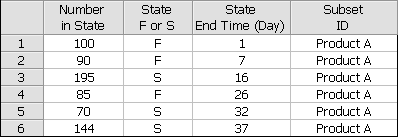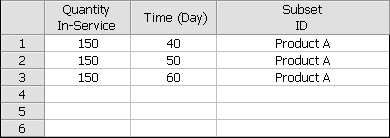![]()
![]()
| Related Topics: | ||
![]()
If your warranty claims data are already in terms of failure/suspension times, you can use the times-to-failure format to forecast future warranty returns.
In the times-to-failure format, you can use any time units appropriate for your data by clicking the Change Units icon on the Main page of the folio's control panel.
![]()
This opens the Change Units window, which gives you a selection of time units to use. The units that are available in the drop-down list are defined at the database level. When you select new units, the appropriate columns in the data sheet will be automatically configured for the time units you selected, and the new unit will be displayed next to the results in the control panel.
The times-to-failure format consists of two data sheets: Data and Future Sales. Data entry is similar to entering data in a Weibull++ standard folio. The following picture shows an example of the data sheet. In this example, the values in the State End Time column are measured in days.

The Subset ID column is for logging any pertinent information or comments about the data. You can also use the Subset ID column to categorize subpopulations in your data set. You will be able to choose a distribution appropriate for each subset of data by selecting the Use Subsets option on the Main page of the control panel.
Note: The subset ID can be any text up to 30 characters, including spaces. For example, “A _ _ X” is not the same as “A _ X” where “ _ ” is used to designate a space.
The Future Sales sheet, shown next, gives you the option to enter projected sales figures. The information in this sheet is used in the forecast analysis. Enter the number of units to be sold in the Quantity In-Service column and enter the anticipated manufacturing/sales/shipment period in the Time column.

Note: For the column heading in this sheet, the general term in-service represents the closest estimate of the time at which each unit started operating in the field. For example, if you have access to both the manufacturing period and the shipping period for a group of parts, you may choose to perform the analysis based on the shipping period because it is a closer indicator of the time the product started operating in the field.
To perform the warranty analysis, go to the Main page of the warranty folio control panel and choose a failure distribution for the data set and a parameter estimation method (you can also choose the parameter estimation settings from the Analysis page of the control panel). Click Calculate.
Click anywhere within the Analysis Summary area of the control panel to open the Results window, which shows the failure/suspension data and the parameters of the life distribution model. From the Results window, you can edit, copy or print the results.
Because the data set is already in terms of failures and suspensions, you can immediately proceed to generating warranty forecasts.
© 1992-2015. ReliaSoft Corporation. ALL RIGHTS RESERVED.